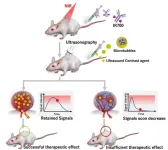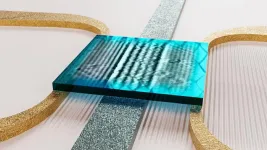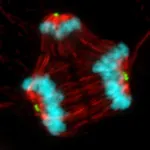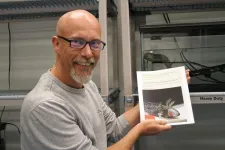(Press-News.org) Researchers at Nagoya University in Japan and their collaborators have used a biomarker based on microbubbles to evaluate the success of near-infrared photoimmunotherapy (NIR-PIT) treatment. Using ultrasound to track the microbubbles, they were able to identify areas where cancer therapy had not been fully applied. Their findings suggest ways to improve NIR-PIT and make it a viable alternative treatment for various types of cancer.
NIR-PIT is an innovative cancer treatment that combines the use of antibodies and near-infrared light to selectively destroy cancer cells while protecting healthy tissues. The antibody targets and binds to cancer cell proteins, creating a light-absorbing substance called IR700. When exposed to near-infrared light, IR700 activates and releases energy that destroys cancer cells. NIR-PIT is considered the fifth cancer treatment, along with surgery, radiation, chemotherapy, and cancer immunotherapy. Improving treatment could have important implications for cancer patients.
To effectively treat a tumor, physicians must determine the optimal level of light intensity to destroy abnormal cell growth while avoiding causing damage to healthy cells. However, it is difficult to ensure uniform irradiation of target cells during surgery because the host tissue reflects and scatters light. Since insufficient light irradiation to the whole tumor risks undertreatment, physicians need an indicator to judge its effectiveness.
To determine the best way to do this, Dr. Kazuhide Sato of Nagoya University Graduate School of Medicine and his collaborators looked at differences in tumor vessels compared to host cells. Past studies have reported that tumor vessels have irregular shapes, gaps between cells, and poor drainage. During NIR-PIT treatment, this poor drainage helps therapeutic nanoparticles stay in the tumor. They then enter cancerous tissue, resulting in a therapeutic effect known as the enhanced permeability and retention (EPR) effect.
In NIR-PIT treatment, rapid tumor cell death caused by the treatment increases permeability in the tumor vessels. This leads to a ‘super EPR effect’ (SUPR), an EPR effect that is 24-times higher than other therapies. If the SUPR effect occurs all over the tumor, it is likely that the treatment has been successful, whereas if it is isolated to certain regions, it is less likely that the treatment has been successful.
To assess this, they tested whether, using the increased permeability, larger fluorescent nanoparticles, such as Sonazoid microbubbles, could be retained. Microbubbles offer an easy way to measure the SUPR effect as they can be easily detected by reflecting harmonic signals off them.
“We investigated with larger-sized fluorescent particles of 2 mm and 5 mm sizes”, said Sato. “We found that retention increased with both sizes.” Using ultrasound imaging to track microbubbles, they created a novel biomarker that could measure the SUPR effect before and after treatment and evaluate the effectiveness of NIR-PIT. “In short, the higher the retention, the higher the anti-tumor effect of NIR-PIT,” he explained.
Sato hopes that their discovery will improve the treatment of cancer patients. “Using this new concept, we could confirm and predict the effects of the treatment after NIR light irradiation,” he said. “This is especially important for patients who receive insufficient treatment. Additional irradiation could be performed flexibly. Since ultrasound imaging equipment has already been introduced in most hospitals and the microbubble contrast agent used in this study has already been approved, this technology is easy to translate to the clinic.”
This research involved collaboration with several institutions at Nagoya University, including the Graduate School of Medicine, the Institute of Advanced Research, the Graduate School of Engineering, and the Institutes of Innovation for Future Society, as well as the Institute for Quantum Life Science and JST. They published their study in EBioMedicine (The Lancet).
END
A new NIR-PIT biomarker paves the way for targeted cancer treatments
2023-10-27
ELSE PRESS RELEASES FROM THIS DATE:
Number of dementia cases could be 42% higher than previously estimated by 2040
2023-10-27
Up to 1.7 million people could be living with dementia in England and Wales by 2040 – over 40% more than previously forecast – finds a new UCL-led study.
Previous studies, based on data up to 2010, showed that dementia incidence had declined in high-income countries. However, the new research, published in The Lancet Public Health, indicates that dementia incidence started to increase in England and Wales after 2008.
Based on this estimated upward incidence trend, researchers project that the number of people with dementia in England and Wales may be significantly higher than expected in the future.
According to previous research* in England ...
Youngest children in class with ADHD as likely to keep diagnosis in adulthood as older pupils, find scientists
2023-10-27
Lancet Psychiatry study shows for first time that younger children are no more likely to lose ADHD diagnosis over time than older classmates
Experts in charge of study examined data from more than 6,500 patients with ADHD
360 million people worldwide have been diagnosed with the condition according to WHO – with around a third under the age of 18
Children who are the youngest in their class to be identified with ADHD are just as likely to keep the diagnosis as older pupils in their year group, scientists have found.
Experts from the University of Southampton ...
Effective treatment for rare sight-threatening infection
2023-10-27
A drug candidate, based on pioneering UCL and Moorfields Eye Hospital research and currently under development by SIFI S.p.A., has been found to be highly effective in treating a rare sight-threatening eye infection in a new international clinical trial.
The findings, published in Ophthalmology, describe the efficacy and safety of the first drug candidate for the treatment of Acanthamoeba keratitis (AK), applying a novel and evidence-based treatment protocol.
AK is one type of microbial keratitis (corneal infection) – a condition ...
Controlling waves in magnets with superconductors for the first time
2023-10-27
Quantum physicists at Delft University of Technology have shown that it’s possible to control and manipulate spin waves on a chip using superconductors for the first time. These tiny waves in magnets may offer an alternative to electronics in the future, interesting for energy-efficient information technology or connecting pieces in a quantum computer, for example. The breakthrough, published in Science, primarily gives physicists new insight into the interaction between magnets and superconductors.
Energy-efficient substitute
"Spin waves are waves in a magnetic material that we can use to transmit information," explains ...
$1.5 million DOD grant will create virtual reality test to assess TBI in the field
2023-10-27
One of the most common injuries sustained by military personnel in recent conflicts has been traumatic brain injury, or TBI. In response to this, and the fact that military operations are increasingly being conducted by small teams in far-flung areas, researchers in the University of Arizona College of Medicine – Tucson’s Department of Psychiatry are working on a portable virtual reality system to assess TBI in the field.
Psychiatry professor William “Scott” Killgore, PhD, and his team in the Social, ...
Antibody-drug conjugate helps patients with metastatic non-small cell lung cancer live longer, delaying disease progression
2023-10-27
Treatment with datopotamab deruxtecan (Dato-DXd), a novel Trop-2 directed antibody-drug conjugate, was found to significantly improve progression-free survival in patients with metastatic non-small cell lung cancer, an improvement that was primarily driven by patients with non-squamous tumors.
These results from the TROPION-Lung01 Phase III trial, which compared the standard of care in second-line docetaxel, a type of chemotherapy, with Dato-DXd, an antibody drug conjugate, in patients with pretreated metastatic non-small cell lung cancer, were presented at the European Society for Medical Oncology 2023 Congress by Dr. Aaron ...
UTHSC cancer researcher part of $3 million collaborative project studying obesity-related cancer
2023-10-27
A University of Tennessee Health Science Center (UTHSC) researcher is a member of a prestigious team that has just received a highly competitive Endeavor Award totaling $3 million from The Mark Foundation for Cancer Research.
Liza Makowski, PhD professor in Hematology and Oncology at the UTHSC Center for Cancer Research, is a co-principal investigator on the award, which funds collaborative projects tackling complex challenges in the prevention, diagnosis, and treatment of cancer. Entitled “Inflammatory Drivers of The Obesity-Cancer Connection”, the project is led by principal ...
Common chemotherapy drugs don't work like doctors thought, with big implications for drug discovery
2023-10-27
A new study from the University of Wisconsin–Madison suggests that chemotherapy may not be reaching its full potential, in part because researchers and doctors have long misunderstood how some of the most common cancer drugs actually ward off tumors.
For decades, researchers have believed that a class of drugs called microtubule poisons treat cancerous tumors by halting mitosis, or the division of cells. Now, a team of UW–Madison scientists has found that in patients, microtubule poisons don't actually stop cancer cells from dividing. Instead, these drugs alter ...
SynGAP Research Fund awards $100,000 for investigating the impact of SYNGAP1 missense variants using structural bioinformatics
2023-10-26
TURKU, Finland – October 27, 2023 – The SynGAP Research Fund 501(c)(3) announced a $100,000 grant to researchers Pekka Postila and Olli Pentikäinen from the Institute of Biomedicine and InFLAMES Flagship at the University of Turku. Prof. Pentikäinen’s research focuses on molecular modeling and computer-aided drug discovery. Assoc. Prof. Postila is an expert on advanced molecular dynamics simulations of complex biomolecular systems. The dual research team was formed to study the structural effects of missense variants on the SynGAP protein, whose normal functioning ...
Something to chew on: Researchers look for connections in how animals eat and digest food
2023-10-26
Oct. 26, 2023
Media contacts:
Emily Gowdey-Backus, director of media relations, Emily_GowdeyBackus@uml.edu
Nancy Cicco, assistant director of media relations, Nancy_Cicco@uml.edu
UMass Lowell’s Nicolai Konow wants to bridge the gap between research on food processing and nutrient absorption.
“There is a divide between biomechanists, who study chewing and food transport, and physiologists, who examine what actually happens to food in the gastrointestinal tract,” said the assistant professor ...





